A LINEAR COMBINATION WITH - Smarandache Notions Journal
advertisement
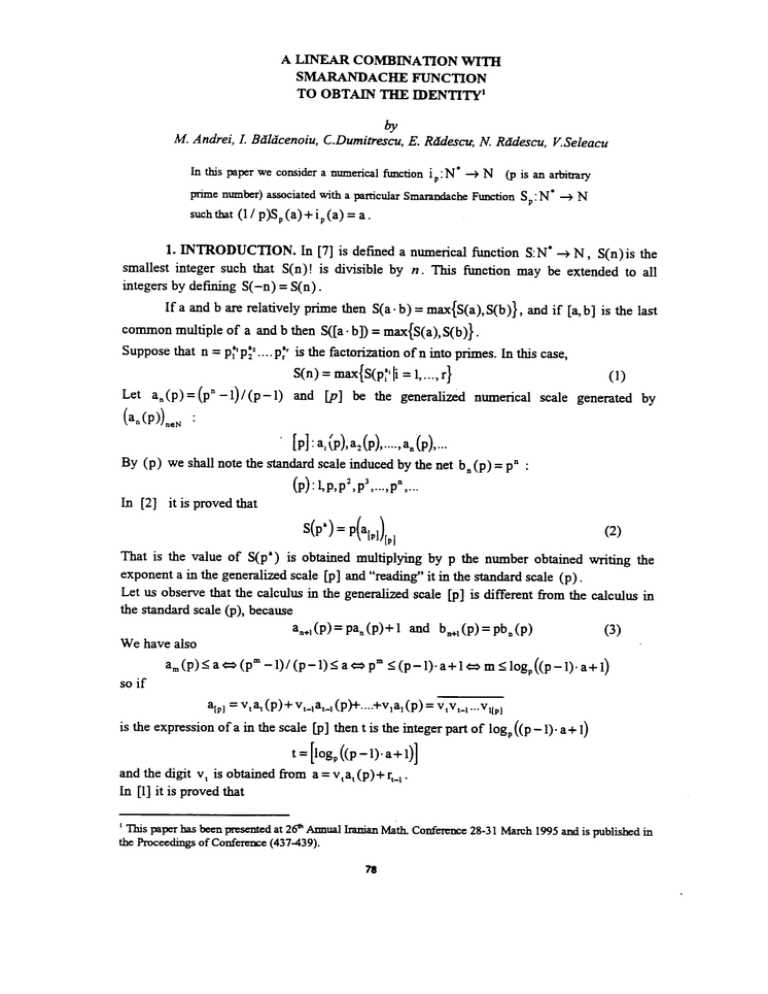
A LINEAR COMBINATION WIm
SMARANDACHE FUNCTION
TO OBTAIN THE IDENTITY'
by
M. Andrei, I. BiIliIcenoiu, C.Dumitrescu, E. RiIdescu, N. RiIdescu, V.Seleacu
In this paper we consider a numerical fimction i p: N* ~ N
(p is an arbittary
prime number) associated with a particular Smarandache Function Sp: N* ~ N
such that (1/ p)Sp (a)+ ip (a)
=a.
1. INTRODUCTION. In [7] is defined a numerical function S:N* ~ N, S(n)is the
smallest integer such that S( n)! is divisible by n. This function may be extended to all
integers by defining S( -n) =S( n) .
If a and b are relatively prime then S( a . b) = max{S(a), S(b )}, and if [a, b] is the last
common multiple of a and b then S([a . b]) =max{S( a), S(b )} .
Suppose that n = p;'p;' .... p;' is the factorization ofn into primes. In this case,
Ii
S(n) = max{S(p:i = 1, ... , r}
(1)
Let an (p ) = (p n -1) / (p -1) and [P] be the generalized numerical scale generated by
(an (p ») neN
:
. [p]: a.\p),a 2 (p),· ... ,an(p),···
By (p) we shall note the standard scale induced by the net b n(p) =pn :
(p): I,p,p2 ,p3 , ... , pn , ...
In [2] it is proved that
(2)
That is the value of S(p') is obtained multiplying by p the number obtained writing the
exponent a in the generalized scale [P] and "reading" it in the standard scale (p).
Let us observe that the calculus in the generalized scale [P] is different from the calculus in
the standard scale (P), because
a n+J(p)=pa n(p)+1 and bn+J(p)=pbn(p)
(3)
We have also
am (p)~ a <=> (pm -1)/ (p-l)~ a <=> pm ~ (p-l)·a+ 1 <=> m ~ logp(p- 1). a+ 1)
so if
alp]
=vtat (p)+vt_Ja
t_
J(p)+ ... .+vJa)(p) =VtVt_J···v)[p]
is the expression of a in the scale [P] then t is the integer part of logp (p -1)· a + 1)
t =[logp (p -1)· a+ 1)]
and the digit v t is obtained from a = v tat (p) + rt_J .
In [1] it is proved that
I This paper has been presented at 26'" AImual Iranian Math. Conference 28-31 March 1995 and is published in
the Proceedings of Conference (437-439).
S(p') = (p-I)· a+O'[p)(a)
where O'[p)(a) = VI +v 2 + ...+v".
A Legendre formula asert that
a!=
(4)
ITpiE,;(a)
p;Sa
p;pnm
where Ep(a)=
I,[~].
p
j;!I
We have also that
as])
(5)
and
([1])
J
Ep(a)=([;]
(p)
[pI
In [I] is given also the following relation between the function Ep and the Smarandache
function
) p-I
s( Pa) = (P_I)2(
Ep(a)+a +--O'[p)(a)+O'[p)(a)
p
p
There exist a great number of problems concerning the Smarandache function. We present
some of these problem.
P. Gronas find
«3]) the solution of the diophantine equation
Fs (n) = n, where
Fs(n)= I,S(d). The solution are n=9, n=16 orn=24, orn=2p, where p is a prime number.
cIIn
T. Yau «8]) find the triplets which verifies the Fibonacci relationship
S(n) = S(n + 1)+S(n +2).
Checking the first 1200 numbers, he find just two triplets which verifies this relationship:
(9,10,11) and (119,120,121). He can't find theoretical proof.
The following conjecture that: "the equation S(x) = S(x+ 1), has no solution", was not
completely solved until now.
2. The Function ip(a). In this section we shall note S(p')= Sp(a). From the
Legendre formula it results
a
4]) that
S,(.)=P(.-i,(.») with O';i,(.):>[ ';1] .
(6)
That is we have
(7)
and so for each function Sp there exists a function ~ such that we have the linear combination
(7) to obtain the identity.
In the following we keep out some formulae for the calculus of ~ . We shall obtain a duality
relation between ~ and ~ .
k
k-I
Let a(p) = Uk Uk_I ... ·. UIUo = UkP + Uk_1P + .....+UtP + Uo •
Then
71
a = (p-l{ Uk pk -1 + Uk_I pk-I -1 + ....+u l P-l)+(U k +Uk_1+ ...+U1)+u o =
'\.
p-l
p-l
p-l
(p-J[;]
\
J
(p)
+ O'(p) (a) = (p-l)E p(a) +O'(p)(a)
(8)
[p]
From (4) it results
(9)
So,
Sp (a) = (p -1)2Ep (a)+ (p-lp(p)(a)+O'[p](a)
(10)
From (4) and (7) it results
.
a-O'[p](a)
Ip(a):--~­
(11)
p
and it is easy to observe a complementary with the equality (5).
Combining (5) and (11) it results
(p -I)Ep (a)+O'(p)(a)-O'[p]
.
Ip(a) = ~-~~-~~~~
(12)
p
From
a=vlvl_l",vl[p]=VI ( PI-I +p 1-2 + .........+p+ 1) + VI_I (1-2
P +p 1-3 + .........+p+ 1) +
+ ..... .+v 2(P+ I)+VI
it results that
a= ( VIP I-I +vl_IP 1-2 + ......+V1P+VI ) +VI (1-2
P +p I-I + ....+ 1) + VI_I (1-3
P +p 1-4 + ...+ 1)+.... .+
v 3(p+ I)+v2 = (a[p])
(p)
+[~]_[.......t.O'[~p](_a)]
p
p
because
[
a] = [ VI (1-2
VI
(1-3
1-4
) VI_1
P
P +p 1-3 + ...+p+ 1) +p+V
I_1 P +p + ....+p+l +-p+ ....+
V
V
v,
2 +_1 J=V (pl-2+ l-3+...+ + )+
+v3(p+I)+-3 +V 2+ p
p I
I
P
p
p
+ VI_l ( p 1-3 +p 1-4 + ...+p+ 1"rr",+v3 (1)
p+ +V2 + [O'[p](a)]
P
we have [n+x]=n+[x].
Then
a = (a )
[p] (p)
+[~]_[O'[p](a)]
p
p
or
It results that
10
(13)
(14)
From (11) and (14) we obtain
i,(a)=[;]-[C1"t)]
(15)
It is know that there exists m,n e N such that the relation
[m;nH:]-[;]
(16)
is not verifies.
m-n
But if - - e N then the relation (16) is satisfied.
p
From (11) and (15) it results
This equality results also by the fact that ip(a)e N.
From (2) and (11) or from (13) and (15) it results that
ip (a) = a - (CirP])(p)
(17)
From the condition on i, in (6) it results that .<1 =[ a; I]_i,(a)" o.
To calculate the difference .<1 =
[a; I] -i, (a) we observe that
.<1=[ a;I]_i,(a)=[ a;I]-[:H C1,,~(a)]
For ae[kp+l,kp+p-Ij we have [a;I]=[;] so
.<1=[ a;I]_i,(a)=[ C1,,~(a)]
(18)
(19)
If a=kp then [a;l]=[kpp-I]+_ ~]=k-I and [:]=k.
So, (18) becomes
.<1 =[a; 1]_ i,(a)= [C1,,~(a)]_1
Analogously, if a = k:p + p , we have
[a;l]=[ p(k+ 1)-1
+[k+1- ]= k
~
(20)
and
[:]= k+1
so, (18) has the form. (20).
For any number a, for which L1 is given by (19) or by (20), we deduce that L1 is maximum
when O"[p](a) is maximum, so when
1_
aM = (p- I)(p- I) ... (p-l)p
,
..
'
81
(21)
[pI
That is
aM = (p -I)at(p)+(p-I)at-l(p)+····+(p -1)a2(p)+ p =
pt_ 1 pt-I_l
p2_ 1)
=(p-I)( - - +
+ ...+ - - +p=
p-I
p-l
p-I
= (pt + pt-I+...+ p 2 + p)-(t-I) = pat(p)-(t-l)
It results that aM is not multiple of p if and only if t -I is not a multiple of p.
In this case u[pj(a)= (t-I)(p-I)+ p = pt-t+ 1 and
,1
So
=[ar'~(')] +_ t; I]:t_[t; I].
i'('M)~[ 'Mp-I]_t or i'('M)e[ ""p-I]_t,[ 'Mp-I].If t-Ie(kp,kp+p) then
and
[ t-I]=k
p
k(p-I)+I<~(aM)<k(p-I)+p+1
so lim
'w-
~(aM)=oo.
We also observe that
[
Then if aM
~
00
ip(aM)
From [
a ]
-I
_M_
P
pkp+P+1 -I
aM -I] = at (P)-[!=!] = pt.1 -I [!=!]e[pkp+1 -I k,..lo...-.-p-I
p
P
p-I
P
p-I
(as pX), it results that
~(aM) ~ 00
(as x).
at(p)-t
.
. ip(a)
[
] ~ 1 It results hm
] =1.
t-2
. - [a-Ip
~(p) _ _
P
Current Address: Department of Mathematics, University of Craiova, AI.Cuza. No.D, Craiova, 1100,
ROMANIA
BmLIOGRAPHY
[I] M. Andrei, C. Dumitrescu, V. Seleacu, L. Tutescu, ~t Zanfu, La fonction de
Smarandache une nouvelle fonction dans 1a theorie des nombres, Congres
International H. Poincare, Nancy 14-18 May, 1994.
[2]M. Andrei, C. Dumitrescu,V. Se!;acu,L.Tutescu, ~t Zanfu, Some remarks on the
Smarandache Function, Smarandache Function Journal, Vol. 4, No.1 (1994), 1-5.
[3] P. Gronas, The Solution of the Diophantine Equation Sh (n) = n, Smarandache
Function J., V. 4, No.1, (1994), 14-16.
[4] P. Gronas, A note on S(pr), Smarandache Function J., V. 2-3, No. I, (1993), 33.
[5] P. Radovici-Mlirculescu, Probleme de teoria elementari a numerelor, Ed. Tehnica,
Bucure¢, 1986.
[6] E. lUdescu, N. lUdescu, C. Dumitrescu, On the Sumatory Function Associated to the
Smarandache Function, Smarandache Function J., V. 4, No.1, 1994), 17-21.
[7] F. Smarandache, A Function in the Number Theory, An. Univ. Timiioara ser. St. Mat
Vol XVIII, fasc. 1 (1980), 79-88.
[8] T. Yau, A problem concerning the Fibonacci series, Smarandache Function J., V. 4,
No.1, (1994)
82
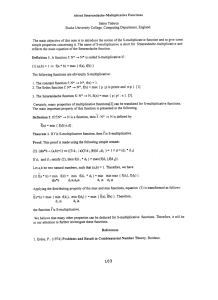

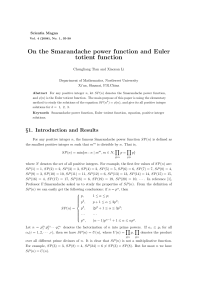
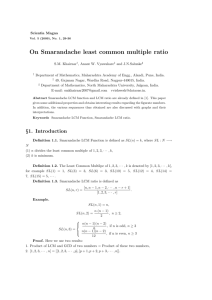
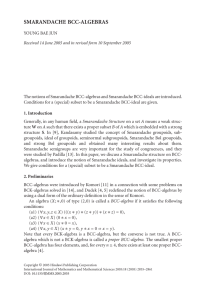

![Anti-Melanoma Associated Antigen 100+ / 25kDa antibody [NKI/C3] ab36616](http://s2.studylib.net/store/data/012190114_1-63b07af4e620ee19f9e033dbaa390d89-300x300.png)